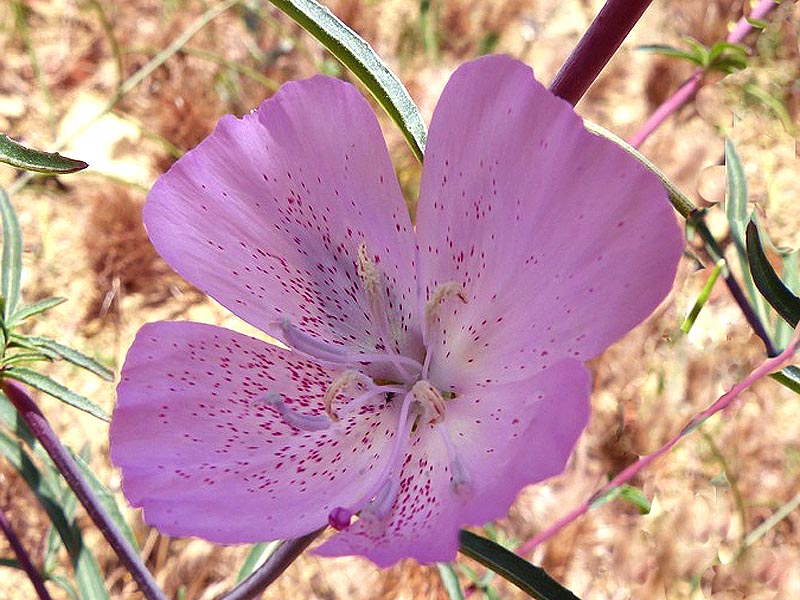Fragile looking but tough. This annual Native American wildflower, native to California. Likes full sun in most locations and prefers poor soils either sand or clay, its also tolerates salt so is ideal for shore gardens or areas close to roads that are salted in winter. Cannot tolerate waterlogged soils but needs regular watering until mature then its fairly drought tolerant. About 90 days from seed to flower best direct sown as does not take well to transplanting. Planting relatively close together encourages more prolific blooming and beats out any weeds. Easy to grow and very easy to enjoy. Best sown in large drifts for maximum effect. Wildlife don't usually eat it but pollinators adore it, high nectar content attracts multitudes of butterflies and native bees. Commonly used in pollinator wildflower mixes.
Growing Punch Bowl Godetia (Clarkia bottae) from Seed.
Godetia don't transplant well so direct sowing where flowers are required is usually the best method. As soon as frost danger has passed clear the area, remove all weeds leaving only bare ground the gently sow the seeds on the surface of the soil. Gently pat or step on the are to press seeds into the soil. Do not cover seeds as they need light to germinate. Spreading straw mulch or other mediums over the sown seeds also constitutes covering and will reduce germination. Leave seeds open to the sun. Germination is usually in about 7-10 days but can take up to 30 days depending on local temperatures. Keep lightly moist during this period, water with fine spray setting on the hose to avoid washing away seeds.
In warmer zones seeds can be sown in late summer through fall for winter/spring flowering. Does not tolerate cold or frost so ensure your area is free before planting.
If choosing to start seeds indoors for early flowering sow seeds with several seed to a small pot. A 3.5 inch (8cm) pot could have up to 4 seeds. Allow plants to grow indoors but as soon as frost has passed place outside to harden off move slowly to direct sun then transplant carefully removing the pot without disturbing the roots. Plants moved in this manner will still sit for a while acclimatizing to their new location but should strengthen up faster and be more robust than individual transplants. Should produce flowers faster than direct sown but may always be weaker plants.
In all instances do not thin plants as crowding seems to encourage more prolific blooming, and since flowers on this species are smaller it produces a much better display.
Location will depend on your zone. In very cool zones 5 and above full sun and fairly sheltered location is ideal, avoid areas where there are frequent cold breezes.
In zones 6a thru 8a full sun in open areas where the plants can catch cool breezes as much as possible. These plants do not like strong heat but usually do well in these locations provided there is enough air flow.
In zones 8b and warmer especially in areas where humidity is high pick a location that receives good airflow and breezes but also has partial shade especially from noon sun. Spots that get morning or evening sun only and catch breezes would be ideal.
Water. Plants need to be kept moist as they are germinating and growing but once they reach maturity and look as if they are going to flower water can be reduced or even removed. No water should be necessary in areas with regular rainfall. Godetia is very drought tolerant once it is mature.
Soil Type. Its not really fussy about soil type but it must be well drained , wet soil causes the roots to rot. Does very well in poor soils especially sandy or rocky soils but can work well in clay also, less prolific in rich soils. It is very salt tolerant so is ideal for shore gardens and along garden edges that may have high salt concentrations from winter road salting.
Pollinator and Wildlife with Punch Bowl Godetia (Clarkia bottae).
Prolific pollen and nectar producer attracts hoards of butterflies, native bees especially tiny sweat bees and Honey bees but a huge host of other bees and pollinators as well. Due to its high pollen production it is often included in native wildflower mixtures that are targeted at bee and butterfly gardens. for best results from a pollinator standpoint it plants in drifting beds 3 x 6 feet (m-1.8m) in diameter for maximum effect.







